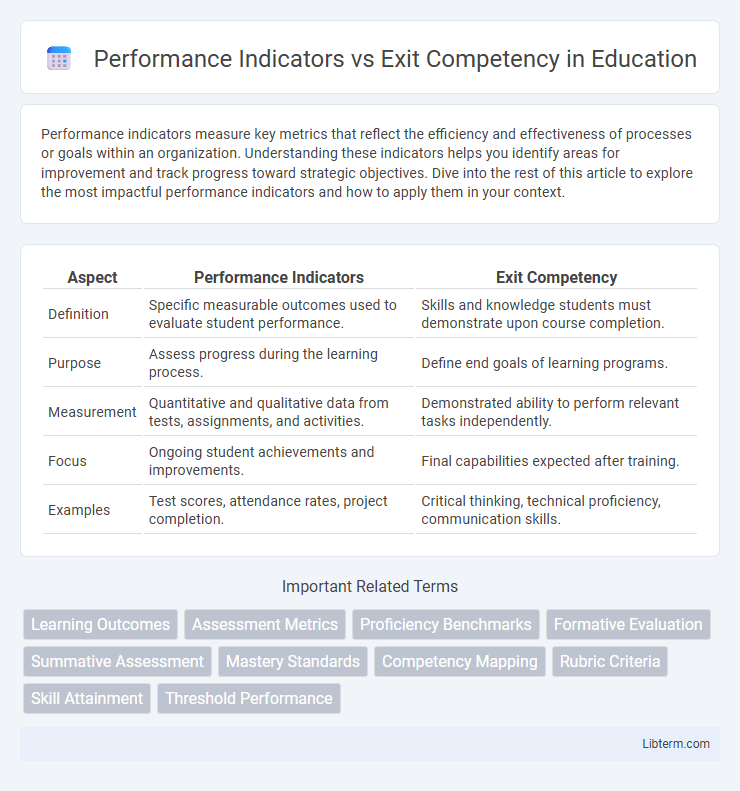Performance indicators measure key metrics that reflect the efficiency and effectiveness of processes or goals within an organization. Understanding these indicators helps you identify areas for improvement and track progress toward strategic objectives. Dive into the rest of this article to explore the most impactful performance indicators and how to apply them in your context.
Table of Comparison
| Aspect | Performance Indicators | Exit Competency |
|---|---|---|
| Definition | Specific measurable outcomes used to evaluate student performance. | Skills and knowledge students must demonstrate upon course completion. |
| Purpose | Assess progress during the learning process. | Define end goals of learning programs. |
| Measurement | Quantitative and qualitative data from tests, assignments, and activities. | Demonstrated ability to perform relevant tasks independently. |
| Focus | Ongoing student achievements and improvements. | Final capabilities expected after training. |
| Examples | Test scores, attendance rates, project completion. | Critical thinking, technical proficiency, communication skills. |
Understanding Performance Indicators
Performance indicators measure specific, quantifiable milestones that track progress toward desired outcomes within a learning or work environment. These indicators provide clear benchmarks for assessing individual or team performance, enabling targeted improvements and data-driven decision-making. Understanding performance indicators is crucial for aligning daily activities with strategic goals and ensuring consistent competency development.
Defining Exit Competency
Exit competency defines the specific skills, knowledge, and abilities a learner must demonstrate upon completing a course or training program. It serves as a measurable outcome that ensures individuals meet established standards for proficiency in their field. Performance indicators are the observable and quantifiable metrics used to assess whether these exit competencies have been achieved.
Key Differences Between Performance Indicators and Exit Competency
Performance indicators measure specific, quantifiable outcomes that reflect an individual's or organization's progress toward goals, while exit competency describes the essential skills and knowledge a learner must demonstrate upon completing a program. Performance indicators are often numeric and time-bound, providing ongoing assessments during the learning process, whereas exit competency is a summative evaluation marking readiness for advancement or certification. Key differences lie in their purpose: performance indicators monitor incremental progress, whereas exit competency defines the final benchmark of proficiency.
The Role of Performance Indicators in Education
Performance indicators in education measure specific student learning outcomes and instructional effectiveness, providing quantifiable data to guide curriculum improvement and teaching strategies. These indicators help educators identify gaps in knowledge and skills, ensuring alignment with exit competencies required for academic progression or workforce readiness. By continuously assessing performance indicators, schools can enhance student achievement and meet established educational standards more effectively.
Importance of Exit Competency for Learner Outcomes
Exit competency directly measures a learner's ability to apply acquired knowledge and skills in real-world scenarios, ensuring readiness for professional challenges. Unlike performance indicators that track progress and engagement during learning, exit competency confirms mastery, which is critical for achieving desired learner outcomes. Prioritizing exit competency helps educators design curricula that align with industry standards and improve overall employability.
Measuring Student Achievement: Indicators vs Competencies
Performance indicators quantify student achievement through measurable data points such as test scores, attendance, and participation rates, providing clear benchmarks for academic progress. Exit competencies define the specific skills, knowledge, and abilities students must demonstrate upon completing a course or program, emphasizing mastery and readiness for subsequent challenges. Comparing these, performance indicators assess ongoing achievement levels, while exit competencies evaluate holistic preparedness and mastery at the completion stage.
Aligning Curriculum with Exit Competencies
Aligning curriculum with exit competencies ensures that performance indicators accurately reflect the skills and knowledge students must demonstrate upon completion. Performance indicators provide measurable benchmarks that guide curriculum development, assessments, and instructional strategies to meet established exit competencies. This alignment enhances educational consistency, accountability, and student readiness for post-graduation challenges.
Best Practices for Developing Performance Indicators
Performance indicators should be specific, measurable, and aligned with exit competencies to accurately assess learner achievements in targeted skills. Best practices include collaborating with subject matter experts to define clear, observable behaviors, using data-driven methods to set realistic benchmarks, and regularly refining indicators based on feedback and performance results. Establishing a direct link between performance indicators and exit competencies ensures meaningful evaluation and continuous improvement in educational outcomes.
Assessing Student Progress: Tools and Strategies
Performance indicators provide measurable criteria such as test scores and project completion rates to track student progress, while exit competencies define the essential skills and knowledge students must demonstrate upon course completion. Effective tools for assessing progress include formative assessments, rubrics, and self-evaluations that align with both performance indicators and exit competencies. Strategies like continuous feedback and adaptive learning platforms enhance the accuracy and relevance of evaluations, ensuring students meet the required competencies before exit.
Integrating Performance Indicators and Exit Competency in Assessment
Integrating performance indicators and exit competency in assessment ensures a comprehensive evaluation of learner outcomes by aligning measurable skills with expected mastery levels. Performance indicators provide specific, quantifiable benchmarks that guide the assessment process, while exit competency defines the overall proficiency learners must demonstrate upon completion. This integration facilitates targeted feedback and supports continuous improvement by linking individual performance metrics directly to the broader competency framework.
Performance Indicators Infographic

 libterm.com
libterm.com